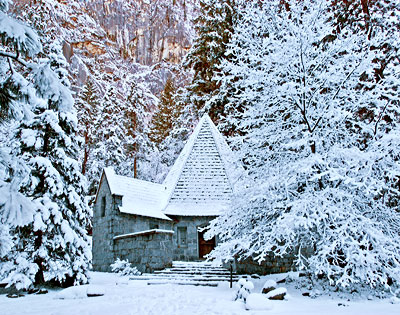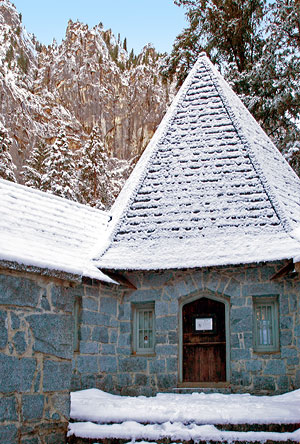National Register of Historic Places in Mariposa County
LeConte Memorial Lodge
Southside Drive Near Curry Village Drive
Yosemite Valley
Built 1903
Relocated 1919
LeConte Memorial Lodge is an unusual structure for a national park. Its Tudor Revival architecture and its European character are found in no other building in the National Park System.
Architect John White was influenced by his brother-in-law, Bernard Maybeck. Both believed that the design of a building was largely determined by its site and construction materials. Architectural interest was derived not from decorative detail but from exposed structure of stone and wood.
A building should be at one with its landscape. The verticality of LeConte Memorial Lodge echoes the cliffs surrounding Yosemite Valley.
White, Maybeck, and others of the Bay Area School agreed with English critic and aesthetician John Ruskin that architecture is frozen music. The repetition of architectural elements - engaged piers, hammer beams, scissors trusses - is like musical rhythm or poetic meter.
Excerpted from the NRHP nomination.

LeConte Memorial Lodge was built for the Sierra Club during the summer and fall of 1903 at the base of Glacier Point adjacent to Camp Curry.
Mother Curry, proprietress of Camp Curry, approached the Sierra Club in 1919 about moving the structure at her expense so that she could expand her camp operation. She proudly provided reasonably priced tent frame cabins for visitors to the Valley. Demand for inexpensive accomodations had far outstripped the numbers she could accomodate in the available space she had.
The Sierra Club agreed to moving the building to a site a short distance west of the original location. Gutleben Brothers Construction Company, hired to move the building, dismantled the roof structure and as much of the original stonework as they could. Their German stonemason and a few other workers rebuilt the lodge according to the original plans.
Excerpted from the NRHP nomination.

LeConte Memorial Lodge honors University of California geologist Joseph LeConte, an early Director of the Sierra Club who died in the Valley in 1901. The Sierra Club provided the Valley's first public information center, first at a small cottage in the old Yosemite Village, and then at the LeConte Memorial Lodge. Although styled a lodge by its founders in the traditional meaning of the term as a gathering place (similar to the Elks Lodge or Masonic Lodge), this small stone building has never been used for overnight accommodations, but rather it is a public building used as a library and education center.
A curator and Sierra Club volunteers serve as summer caretakers providing information to park visitors about Yosemite, the Sierra Nevada, and the National Park Idea. Because the rough-hewn roof and granite walls have no insulation, cold and snow keep the building closed during the winter.
Source: Sierra Club

LeConte Memorial Lodge is a National Historic Landmark.
There are four National Historic Landmarks in Yosemite National Park:

Buildings that Moved
It's not just that the people of the American West are restless, the buildings themselves sometimes pack up and move when - for one reason or another - the neighborhood no longer suits them or the neighbors no longer want them or opportunity waits down the road.
And when buildings remain in place, they are often searching for their identities.
Acting Superintendent's Office, Yosemite
Alford-Nielson House, Ferndale
Alpine Hotel, Markleeville
Ashland Depot Hotel, Ashland, Oregon
Auburn Fire House No. 1, Auburn
Bagby Stationhouse, El Portal
Bayview Hotel, Aptos
Bridgeport Elementary School, Mono County
Calvary Presbyterian Church, Bolinas
Carter House, Ashland, Oregon
Christian Church, Gilroy
Choller Mansion, Virginia City, NV
Chuck's Railroad Room, Westwood
Colfax Freight Depot (Moved Twice), Colfax
Commodore Watkins House, Atherton
Coyle-Foster Barn, Shasta State Historic Park
Croll Building, Alameda
Dallam-Merritt House, San Francisco
Davis Creek Community Church, Davis Creek
Duatre's Store, Monterey
Errea House, Tehachapi
Fairwind, Eureka
First Baptist Church, Sonoma
Fort Bragg Storehouse and Commissary, Fort Bragg
Galarneaux House, Sacramento
Glass House, San Ramon
Glendale School (Moved Twice), Sparks, Nevada
Goleta Depot, Goleta
Gray's Station, Truckee
Hostess House, Palo Alto
Hodgdon Homestead Cabin, Yosemite
House at 2214 Clay Street, San Francisco
Hutton House, Saratoga
Independence Hall, Woodside
J & T Basque Restaurant, Gardnerville, NV
Jamestown Branch Jail (Moved Twice)
Jax Truckee Diner (Moved Twice), Truckee
Jorgensen Studio, Yosemite
King City Depot, King City
La Gloria Schoolhouse, King City
Lagunita Schoolhouse, Salinas
Lake Mansion (Moved Twice), Reno
Lathrop House, Redwood City
LeConte Memorial Lodge, Yosemite
Little Church on the Hill, Oakhurst
Mansion House Hotel, Watsonville
Marcus Books and Jimbo's Bop City, San Francisco
McCredie House, Central Point, Oregon
Meherin House, Pismo Beach
Mendocino Masonic Hall, Mendocino
Methodist Episcopal Church, Placerville
Migliavacca Mansion, Napa
Milton Masonic Hall, Milton
Moab Cabin, Moab, Utah
Old North San Juan School, North San Juan
Rengstorff House, Mountain View
Sylvester House , San Francisco
United Methodist Church, Nevada City
Mt. Buckingham School, Darrah
Old Log Jail (Moved Twice), Markleeville
Old Mammoth Saloon (Moved Twice), Mammoth Lakes
Old St. Mary's Church, Rocklin
Old St. Patrick's Church (Moved Twice), San Francisco
Perry's Dry Goods, Gardnerville, NV
Phelps House (Moved Twice), San Francisco
Reno Arch (Moved Five Times), Reno
Roper House, Ashland, Oregon
San Rafael Improvement Club, San Rafael
St. James Catholic Church, Georgetown
Tribune-Republic Building, San Luis Obispo
Tubbs Cordage Company, San Francisco
Tucker House, Martinez
Twenty Mile House, Cromberg
Webber House, Yountville
Wood House, Modesto
Yosemite Transportation Company
Yosemite Valley Chapel
Of the buildings and structures we have visited, the original Reno Arch holds the record for number of moves. It has been moved five times since it was built in 1926.
Jax Truckee Diner holds the distance title. The building moved from New Jersry to Pennsylvanis in 1948, then from Pennsylvania to Califonia in 1992.
Probably the most ambitious relocation occurred on July 4th 1904, when the Southern Pacific Railroad loaded most of the town of Wadsworth, Nevada, onto rail cars and transported the town thirty miles west to create a new town which became known as Sparks.

